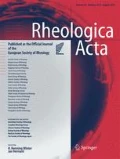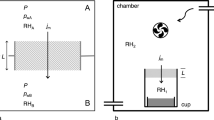Abstract
The coupling effects of temperature and time on the fluidity of fresh cement mixtures were investigated. Mini-cone tests on cement mortars and rheological tests on cement pastes under different temperatures (0 to 60 °C) were conducted to characterize the development of the fluidity of fresh cement mixtures over time. In addition, total organic carbon tests were performed to quantify the adsorption amount of superplasticizers on the cement surface. The amount of free water in cement pastes was determined via centrifugation. Isothermal calorimetry was employed to characterize the hydration kinetics of cement under different temperatures. Results show that the spread diameter of mortars decreases in a roughly linear fashion over elapsed time. Higher temperature facilitates a sharper decrease in fluidity with time, although the initial fluidity of fresh mortars is not significantly affected by temperature. Higher temperature results in a greater amount of adsorbed polycarboxylate ester/ether on the cement surface and a lower amount of free water in fresh cement pastes, which is believed to result from the higher hydration rate of cement. The evolution of rheological properties over time can be attributed to the development of hydration degree. Relative hydration degree is introduced to indicate the development of rheological properties with time. Two models to describe the evolution of yield stress and plastic viscosity for fresh cement pastes were developed.











Similar content being viewed by others
References
Aiad I (2003) Influence of time addition of superplasticizers on the rheological properties of fresh cement pastes. Cem Concr Res 33:1229–1234
Axelsson M, Gustafson G (2006) A robust method to determine the shear strength of cement-based injection grouts in the field. Tunnel Undergr Space Technol 21:499–503
Banfill PFG (2006) Rheology of fresh cement and concrete. Br Soc Rheol 61–130
Banfill PFG, Starrs G, Derruau G, McCarter WJ, Chrisp TM (2006) Rheology of low carbon fibre content reinforced cement mortar. Cem Concr Res 23:773–780
Brouwers HJH, Radix HJ (2005) Self-compacting concrete: theoretical and experimental study. Cem Concr Res 35:2116–2136
Chong H, Franqois DL (1996) The rheology of fresh high-performance concrete. Cem Concr Res 26:283–294
Ferraris CF, Obla KH, Hill R (2001) The influence of mineral admixtures on the rheology of cement paste and concrete. Cem Concr Res 31:245–255
Flatt RJ, Bowen P (2006) Yodel: a yield stress model for suspensions. J Am Ceram Soc 89:1244–1256
Flatt RJ, Bowen P (2007) Yield stress of multimodal powder suspensions: an extension of the YODEL (yield stress model). J Am Ceram Soc 90:1038–1044
Golaszewki J, Szwabowski J (2003) Influence of superplasticizer on rheological behavior of fresh cement mortars. Cem Concr Res 34:235–248
Hammer TA, Wallevik JE (2005) On the correlation between rheology of paste, mortar and concrete. In: Shah SP (ed) Proceedings of the second North American conference on the design and use of self-consolidating concrete and the fourth international RILEM symposium on self-compacting concrete. Chicago
Heikal M, Morsy MS, Aiad I (2005) Effect of treatment temperature on the early hydration characteristics of superplasticized silica fume blended cement pastes. Cem Concr Res 35:680–687
Jolicoeur C, Simard MA (1998) Chemical admixture-cement interactions: phenomenology and physico-chemical concepts. Cem Concr Compos 20:87–101
Kada-Benameur H, Wirquin E, Duthoit B (2000) Determination of apparent activation energy of concrete by isothermal calorimetry. Cem Concr Res 30:301–305
Kong XM, Hu B, Hou SS, Liu BY, Hao XY (2009) Synthesis and application properties study of polycarboxylate-type superplasticizer. J Tsinghua Univ Sci Technol 49:1925–1929 (Chinese)
Kreppelt F, Weibel M, Zampini D, Romer M (2002) Influence of solution chemistry on the hydration of polished clinker surfaces—a study of different types of polycarboxylic acid-based admixtures. Cem Concr Res 32:187–198
Lin F, Meyer C (2009) Hydration kinetics modeling of Portland cement considering the effects of curing temperature and applied pressure. Cem Concr Res 39:255–265
Murata J (1984) Flow and deformation of fresh concrete. Mater Struct 17:117–129
Nehdi M, Martini SA (2009) Estimating time and temperature dependent yield stress of cement paste using oscillatory rheology and genetic algorithms. Cem Concr Res 39:1007–1016
Petit JY, Wirquin E, Duthoit B (2005) Influence of temperature on the yield value of highly flowable micromortars made with sulfonate-based superplasticizer. Cem Concr Res 35:256–266
Petit JY, Khayat KH, Wirquin E (2006) Coupled effect of time and temperature on variations of yield value of highly flowable mortar. Cem Concr Res 36:832–841
Petit JY, Wirquin E, Vanhove Y, Khayat K (2007) Yield stress and viscosity equations for mortars and self-consolidating concrete. Cem Concr Res 37:655–670
Petit JY, Khayat KH, Wirquin E (2009) Coupled effect of time and temperature on variations of plastic viscosity of highly flowable mortar. Cem Concr Res 39:165–170
Petit JY, Wirquin E, Khayat KH (2010) Effect of temperature on the rheology of flowable mortars. Cem Concr Compos 32:43–53
Plank J, Hirsch C (2007) Impact of zeta potential of early cement hydration phases on superplasticizer adsorption. Cem Concr Res 37:537–542
Roussel N, Stefani C, Leroy R (2005) From mini-cone test to Abrams cone test: measurement of cement-based materials yield stress using slump tests. Cem Concr Res 35:817–822
Rubio-Hernández FJ, Velázquez-Navarro JF, Ordóñez-Belloc LM (2013) Rheology of concrete: a study case based upon the use of the concrete equivalent mortar. Mater Struct 46:587–605
Sari M, Prat E, Labastire JF (1999) High strength self-compacting concrete original solutions associating organic and inorganic admixtures. Cem Concr Res 29:813–816
Schwartzentruber A, Catherine C (2000) Method of the concrete equivalent mortar (CEM). A new tool to design concrete containing admixtures. Mater Struct 33:475–482
Sheinn AMM, Ho DWS, Tam CT (2002) Rheological model for self-compacting concrete—paste rheology. In: Proceedings of the 27th conference on our world in concrete and structures. CI Premier, Singapore
Standardization Administration of China and Chinese National Committee of the ISO and IEC (2005) Test method for fluidity of cement mortar. China Standards Press, Beijing
Struble L, Sun GK (1995) Viscosity of Portland cement paste as a function of concentration. Adv Cem Based Mater 2:62–69
Zhao Z, Tang WD, Zhang P (2006) Research on test method for workability of high flowability concrete. Build Sci 22:51–55
Zingg A, Winnefeld F, Holzer L, Pakusch J, Becker S, Figi R, Gauckler L (2009) Interaction of polycarboxylate-based superplasticizers with cements containing different C3A amounts. Cem Concr Compos 31:153–162
Acknowledgments
The support from the National Natural Science Foundation of China (grant no. 51173094, U1262107) is appreciated.
Author information
Authors and Affiliations
Corresponding author
Rights and permissions
About this article
Cite this article
Kong, X., Zhang, Y. & Hou, S. Study on the rheological properties of Portland cement pastes with polycarboxylate superplasticizers. Rheol Acta 52, 707–718 (2013). https://doi.org/10.1007/s00397-013-0713-7
Received:
Revised:
Accepted:
Published:
Issue Date:
DOI: https://doi.org/10.1007/s00397-013-0713-7




